|

by Ethan Siegel
September 23, 2025
from Medium Website
Article also here
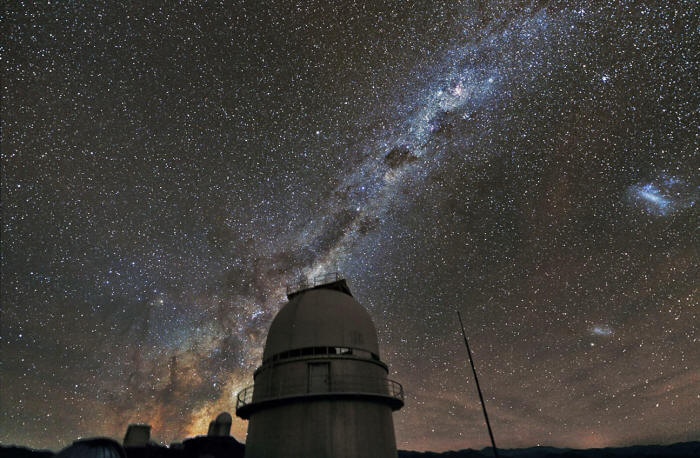
|
Behind the
dome of a series of European Southern Observatory
telescopes, the Milky Way towers in the southern skies,
flanked by the Large and Small Magellanic Clouds, at
right. Although there are several thousand stars and the
plane of the Milky Way all visible to human eyes, there
are only four galaxies beyond our own that the typical
unaided human eye can detect. We did not know they were
located outside of the Milky Way until the 1920s: after
Einstein's general relativity had already superseded
Newtonian gravity. Today, this view helps us appreciate
the awe and wonder that the Universe, and the cosmic
story,
holds for each of us.
(Credit: ESO/Z. Bardon (www.bardon.cz)/ProjectSoft
(www.projectsoft.cz)) |
Questions about our origins,
biologically, chemically, and cosmically,
are the
most profound ones we can ask.
Here are
"today's best answers"...
In all the world, and perhaps in all the Universe, there's no
greater question one can ask than the question of one's own origins.
For us, as human beings, this comes up often in our early childhood:
we see, touch, and experience the world around us, and wonder where
it all comes from.
We look at ourselves and those around us, and
wonder about our own origins.
Even when we look to the heavens, and
take in the spectacular sights of the night sky - the Moon, the
planets, the stars, the glorious plane of the Milky Way, plus
deep-sky objects - we're filled with a sense of awe, wondering where
the lights, and perhaps even the vast, empty darkness that separates
them, all came from.
For millennia, we had only stories to be our guide: mythologies and
untested, unsubstantiated ideas that sprung forth from human
imagination.
However, the enterprise of science has, for the first
time in the history of our species, brought to us compelling,
fact-based answers to many of these questions that enable us to make
sense not just of nature, but of the story for how we came to be.
Biologically, chemically, and physically, advances in the 19th,
20th, and now 21st centuries have enabled us to weave together a
rich tapestry that finally answer the question so many of us have
wondered for so long:
"Where do we come from?"
Here's where we are today, right up to the frontiers of what's
currently known.
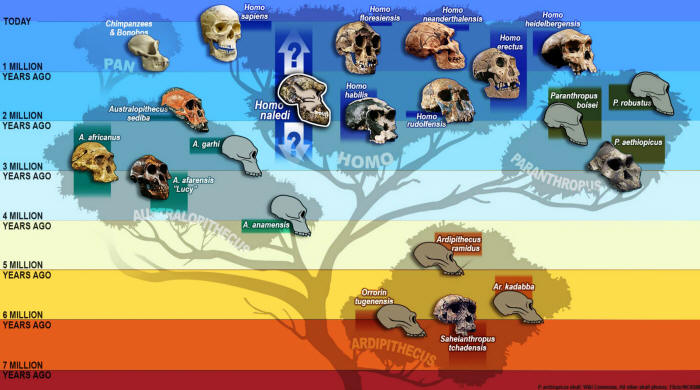
|
The
evolution of modern humans can be mapped out, along with
the history of both our extant and now-extinct cousins,
thanks to an enormous wealth of evidence found worldwide
in the fossil record. Various examples include Homo
erectus (which arose 1.9 million years ago and only died
out ~140,000 years ago), Homo habilis (the first member
of the genus Homo), and the Neanderthal (which arose
later than, and likely independent of, modern humans).
(Credit: S.
V. Medaris / UW-Madison) |
Biologically, we are the descendants of a continuous, unbroken chain
of organisms that go back approximately four billion years.
You are the child of your parents:
a genetic mother and father, each
of whom contributed 50% of your genetic material.
That genetic
material contains an enormous amount of information within it,
telling your body what proteins and enzymes to produce, how to
configure them together, and where and when to activate a variety of
responses.
Your genetics explains nearly everything about your body,
from your eye color to the types of red blood cells you produce to
whether you have a deviated septum in your nose or not.
Your mother
and father, in turn, are descended from their genetic parents - your
grandparents - who were in turn descended from your
great-grandparents, and so on.
It turns out that as we go back, and back, and back still farther,
we find that organisms change over very long periods time, evolving
in the process.
This evolution is driven by a combination of random
mutations and natural selection, where the organisms that are most
fit for survival, and most adaptable to the changes that occur in
their conditions and environment, are the ones who aren't selected
against, and whose lineages continue.
We can extrapolate this back, and back, and back,
to when human ancestors were:
-
other members of the genus Homo,
-
mere hominids that predate the emergence
of our genus,
-
primates that predate the evolution of
hominids,
-
mammals that predate any primate: monkey
or ape,
going all the way back to single-celled asexually
reproducing organisms that existed billions of years ago.
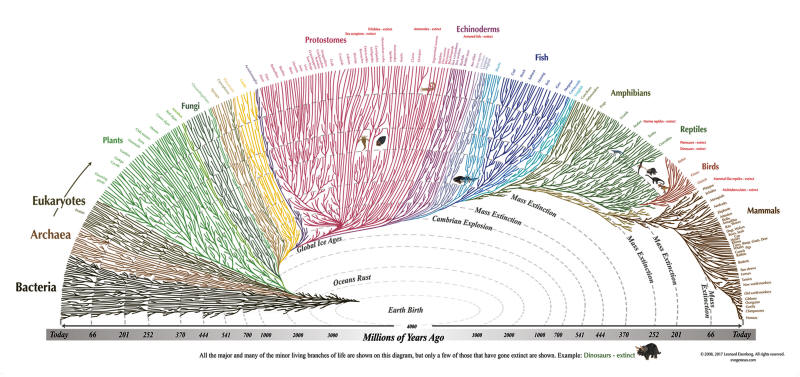
|
This tree of life illustrates the evolution and
development of the various organisms on Earth. Although
we all emerged from a common ancestor more than 2
billion years ago, the diverse forms of life emerged
from a chaotic process that would not be exactly
repeated even if we rewound and re-ran the clock
trillions of times. As first realized by Darwin, many
hundreds of millions, if not billions, of years were
required to explain the diversity of life forms on
Earth.
(Credit: Leonard Eisenberg/evogeneao) |
The oldest, most long-ago evidence we have for
life on Earth goes back at least 3.8 billion years: to the date at
which the oldest sedimentary rocks still at least partially survive.
Earth may have been inhabited even farther back, as circumstantial
evidence (based on carbon isotope ratios from zircon deposits in
even older rocks) suggests that Earth could have been teeming with
life as early as 4.4 billion years ago.
But at some point, back in the environment of our newly formed
planet, we weren't teeming with life at all.
At some point,
a living
organism emerged on Earth for the first time.
It's possible that an
outside-the-box idea, panspermia, is correct, and that the life that
exists here on Earth was brought here, cosmically, from some
elsewhere in space where life arose naturally from non-life.
Nevertheless, at some point in cosmic history, life did emerge from
non-life.
It is presently unknown exactly how that happened, and
what came first:
-
the structure of the cell, separating a
potential organism's insides from the outside environment,
-
a string of nucleic acids that encoded
information, enabling reproduction,
-
or a metabolism-first scenario, where a
protein or enzyme that could extract energy from its
environment formed first, and then reproduction and
cellularity came afterwards.
Although we aren't certain of the pathway that it
took, life did emerge from raw, non-living ingredients in the
distant past.
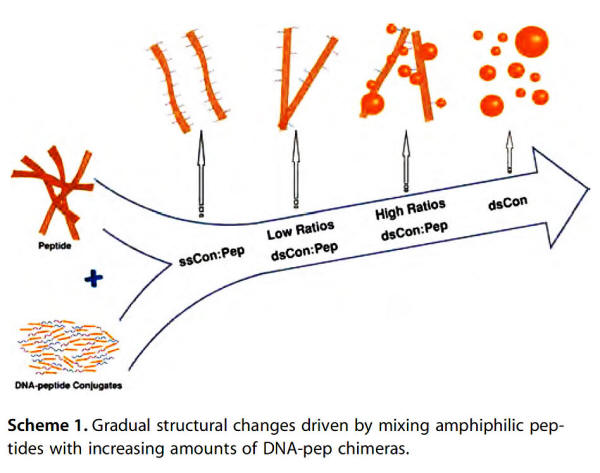
|
If life
began with a random peptide that could metabolize
nutrients/energy from its environment, replication could
then ensue from peptide-nucleic acid coevolution. Here,
DNA-peptide coevolution is illustrated, but it could
work with RNA or even PNA as the nucleic acid instead.
Asserting that a "divine spark" is needed for life to
arise is a classic "God-of-the-gaps" argument, but
asserting that we know exactly how life arose from
non-life is also a fallacy. These conditions, including
rocky planets with these molecules present on their
surfaces, likely existed within the first 1–2 billion
years of the Big Bang.
(Credit: A.
Chotera et al.,
Functional Assemblies Emerging in
Complex Mixtures of Peptides and Nucleic Acid–Peptide
Chimeras,
Chemistry Europe, 2018) |
Therefore, chemically, at some point in the past, whether on Earth
or elsewhere, a metabolism-having replicating organism emerged,
creating an origin point for life.
However, Earth itself, as well as the rest of our Solar System,
needed to be brought into existence in order for there to be life on
Earth at all.
So,
where did the Earth, the Sun, and the rest of the
Solar System come from?
To answer this question, we can look to two
different aspects of nature itself:
We can look to the various radioactive
isotopes (and their ratios) of elements and use them to
determine the age of the Earth, the Sun, and the various
primordial (asteroid and
Kuiper belt) bodies in our Solar
System, determining when
the Solar System formed.
And then we can look at star-formation (and stellar death) all
across the galaxy and Universe, determining how stars are born,
live, and die, and then use that information to trace back how
our Sun and Solar System came into existence.
Here in the 21st century, we've done both of
those things quite robustly.
The Solar System is about 4.56 billion
years old, with the Earth being slightly younger and the Moon being
about 50 million years younger than Earth.
We formed from a
molecular cloud of gas that contracted and formed stars, with the
planets (including primordial planets that may have since been
ejected or destroyed) emerging from a protoplanetary disk that
surrounded our young proto-Sun.
Now, more than four and a half
billion years later, only the survivors - including us - remain.
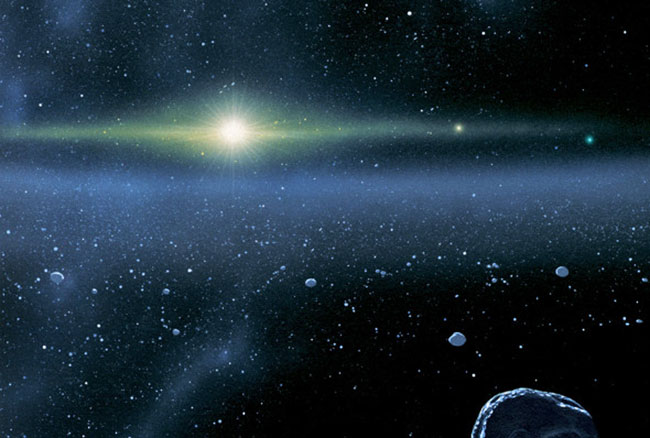
|
Although we
now believe we understand how the Sun and our Solar
System formed, this early view of our past,
protoplanetary stage is an illustration only. While many
protoplanets existed in the early stages of our system's
formation long ago, today, only eight planets survive.
Most of them possess moons, and there are also small
rocky, metallic, and icy bodies distributed across
various belts and clouds in the Solar System as well.
(Credit:
JHUAPL/SwRI) |
Formed the same way that all stellar and planetary systems form, our
own Solar System formed from the contraction of a molecular cloud
that triggered new star formation, giving rise to the Earth, the
Sun, and more.
Once Earth was created, life emerged on it shortly thereafter.
Whether it was rooted in deoxyribonucleic acid (DNA), ribonucleic
acid (RNA), or a peptide-based nucleic acid (PNA), at some point in
the past, a molecule formed that encoded the production of a protein
or enzyme that could metabolize energy, and that was capable of
replicating and reproducing itself:
a vital step towards modern,
living organisms.
But in order for those molecules to form,
precursor molecules needed to exist:
things like amino acids,
sugars, phosphorous-based groups, and so on...
These, in turn, required a slate of raw atomic
ingredients, including:
-
hydrogen
-
carbon
-
nitrogen
-
oxygen
-
phosphorous
-
sulfur
-
calcium
-
sodium
-
potassium
-
magnesium
-
chlorine,
...and much more.
But with the exception of hydrogen, the most abundant element in the
Universe, none of these elements were present in the earliest stages
of cosmic history.
The Universe must have, somehow, created these
elements, as these atomic building blocks are absolutely necessary
to the formation not just of living organisms, but of rocky planets
like Earth themselves.
Fortunately, we do have a cosmic story that accounts for the
emergence of these elements: from the life cycles of stars.
Through,
-
stellar deaths, including from Sun-like stars that die in planetary
nebulae
-
from very massive stars that die in core-collapse
supernovae
-
from neutron stars that collide in kilonovae
-
from
white dwarf stars that explode in type Ia supernovae,
...the heavy
elements of the Universe are created and returned to the
interstellar medium, where they can participate in new episodes of
star formation.
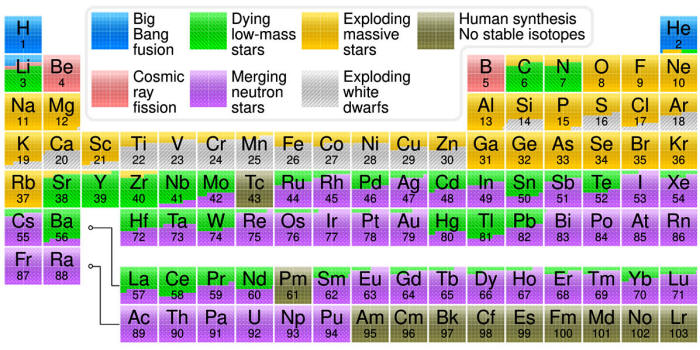
|
The
most current, up-to-date image showing the primary
origin of each of the elements that occur naturally on
the periodic table. Neutron star mergers, white dwarf
collisions, and core-collapse supernovae may allow us to
climb even higher than this table shows. The Big Bang
gives us almost all of the hydrogen and helium in the
Universe, and almost none of everything else combined.
Most elements, in some form or another, are forged in
stars.
(Credit: Cmglee/Wikimedia Commons) |
This teaches us that our Sun, Earth, and Solar System,
were born from
the ashes of pre-existing stars and stellar corpses that lived,
died, and returned their processed interiors to the interstellar
medium.
So,
that's where humans come from, where life comes from, where the
Solar System comes from, and where heavy elements come from.
-
You
need stars to make the raw ingredients to have planets
-
You need a
late-forming star with enough heavy elements in it to make a rocky
planet with the right ingredients for life
-
You need the right
chemical reactions to kick off to create a living creature from
non-life.
-
Then you need the right conditions for life to survive and
thrive over geological timescales, under the pressures of natural
selection, to create the diversity of life we find on Earth today,
including human beings.
But in order for this to occur, you need to make stars for the very
first time, and that requires a set of ingredients and conditions,
too.
You need neutral atoms, and in particular
large numbers of
hydrogen atoms, and that's ok:
they were formed in the early stages
of the hot
Big Bang.
But you also need a non-uniform Universe:
one
with overdense regions that would gravitationally attract more and
more matter into them, until enough matter had gathered that stars
would form for the very first time.
Under the laws of General Relativity, based on
the initial fluctuations we see in the cosmic microwave background,
that's precisely what our Universe gives us:
a set of conditions and
ingredients that enable the formation of stars, for the first time,
from a pristine collection of neutral atoms.
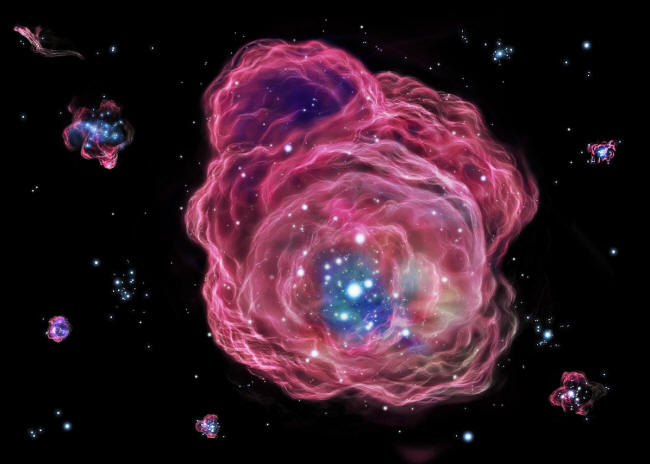
|
The very first
stars to form in the Universe were different than the stars today:
metal-free, extremely massive, and nearly all destined for a
supernova surrounded by a cocoon of gas. There was a time, prior to
the formation of stars where only clumps of matter, unable to cool
and collapse, remained in large, diffuse clouds. It is possible that
clouds that grow slowly enough may even persist until very late
cosmic times.
(Credit:
NAOJ) |
Those very first stars formed early on, back
before the Universe was even 2% of its present age:
the farthest
back that we've ever observed a star, galaxy, or quasar with the
record-setting James Webb Space Telescope (JWST).
They likely formed
simply by gravitational contraction of a gas cloud, and were
hindered by a lack of heavy elements to efficiently cool those
clouds as they contracted, requiring very large masses to gather to
trigger gravitational collapse.
As a result, these first stars,
which still have yet to be spotted, were likely very high in mass,
and very short-lived as a result.
Although we have yet to find the first stars, representing a
"missing link" in cosmic evolution, scientists can be certain they
existed:
in between the massive galaxies spotted by JWST and the
neutral atoms formed way back at the epoch of the cosmic microwave
background.
Nevertheless, we continue in our quest for the ultimate cosmic
origin.
Those stars must have formed from neutral atoms, and in the
framework of the Big Bang - and validated by observations for 60
years, and counting - neutral atoms can only form when the Universe
cools from a hot, dense, plasma state (where all of the atomic
components are ionized) to a less hot, less dense state where
neutral atoms are stable.
In the aftermath of such a transition, a
background of low-energy remnant radiation would be emitted omnidirectionally, persisting even until the present day.
It was the
detection of that remnant primeval radiation, now known as the
Cosmic Microwave Background (CMB), that sealed the deal for the Big
Bang.
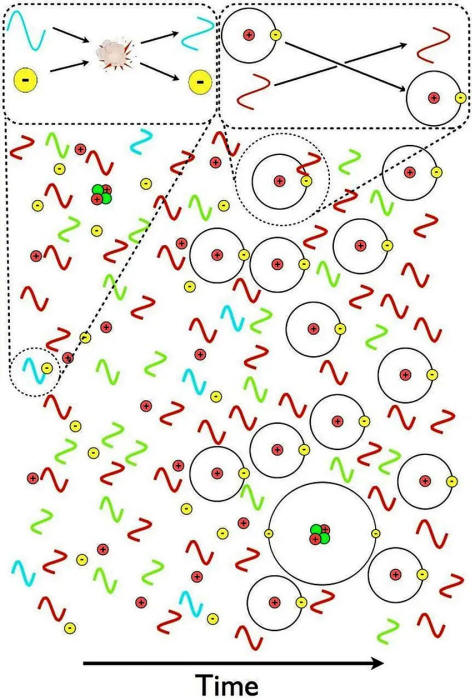
|
At
early times (left), photons scatter off of electrons and
are high-enough in energy to knock any atoms back into
an ionized state. Once the Universe cools enough, and is
devoid of such high-energy photons (right), they cannot
interact with the neutral atoms, and instead simply
free-stream, since they have the wrong wavelength to
excite these atoms to a higher energy level.
(Credit: E. Siegel/Beyond the Galaxy) |
In order to create stars, the Universe needed to
create
neutral atoms, which were produced about 380,000 years after
the onset of the hot Big Bang.
Of course, a hot, dense plasma wasn't the beginning of things
either.
If you continue to extrapolate backwards in time - towards a
hotter, denser, more uniform state - you'd come to a time where it
was too hot and dense to form atomic nuclei; you would have only had
bare protons and neutrons.
At still higher temperatures and earlier
times, the energy of any radiation present (as well as neutrinos and
antineutrinos) would have been sufficient to cause protons and
neutrons to interconvert, leading to a 50/50 split between protons
and neutrons.
Therefore, as the Universe expands and cools from those early
conditions, and these nuclear reactions cease to occur, we should
wind up with a tilted abundance of protons versus neutrons:
one that
favors protons...
Then, as the Universe cools further, nuclear fusion
reactions can proceed, first forming deuterium out of protons and
neutrons and then synthesizing heavier elements, like helium, and
then (if there's enough energy) lithium and heavier elements, after
that.
It's by:
-
measuring the baryon-to-photon ratio of
the Universe,
-
predicting, through nuclear physics, the
abundance of the light elements,
-
and then examining the Universe itself to
learn how abundant the light elements actually are,
...that we learn how Big Bang nucleosynthesis, or
the science of making elements even before the first stars formed,
proceeded.
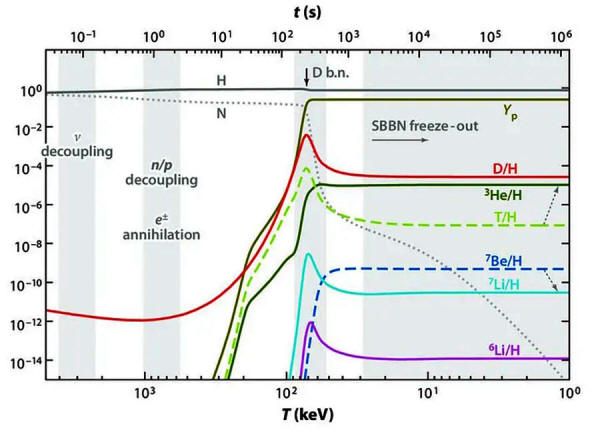
|
This plot shows the abundance of the light elements over
time, as the Universe expands and cools during the
various phases of Big Bang Nucleosynthesis. By the time
the first stars form, the initial ratios of hydrogen,
deuterium, helium-3, helium-4, and lithium-7 are all
fixed by these early nuclear processes.
(Credit: M. Pospelov & J. Pradler, Annual Review of
Nuclear and Particle Science, 2010) |
And indeed, to form the Universe we see, the light elements were
forged together through nuclear reactions in the early stages - the
first few minutes - of the hot Big Bang.
Finally, we go back earlier and earlier, to hotter and even denser
conditions.
At some point, protons and neutrons cease to be
meaningful entities, as the Universe takes on the conditions of a
quark-gluon plasma.
At high enough energies, matter-antimatter pairs
spontaneously get created from photons and other particles
colliding: a consequence of Einstein's mass-energy equivalence, or E
= mc².
All of the particles and antiparticles of the Standard Model,
even the unstable ones, were created in great abundance under these
early conditions. And at early enough times, the electromagnetic
force and the weak nuclear force were unified into one: the
electroweak force.
And yet, despite all we know, some additional gaps and mysteries
still remain.
At some point, even though we don't know how,
more matter was created than antimatter,
leading to our matter-dominated Universe today.
Before that,
Were there additional unifications that occurred?
Was
gravity, at some point, unified with the forces of the Standard
Model, and
was there a Theory of Everything that described reality?
We don't know...
But we do know that
the hot Big Bang, even at its hottest, wasn't the very beginning
of everything.
Instead, the conditions that the Big Bang was
born with:
-
perfect spatial flatness,
-
a lack of leftover, high-energy
relics,
-
with a maximum temperature well below
that of the Planck scale,
-
with the same temperatures and
densities everywhere and in all directions,
-
with tiny, 1-part-in-30,000
overdensities and underdensities superimposed atop them
on all scales, including on super-horizon scales,
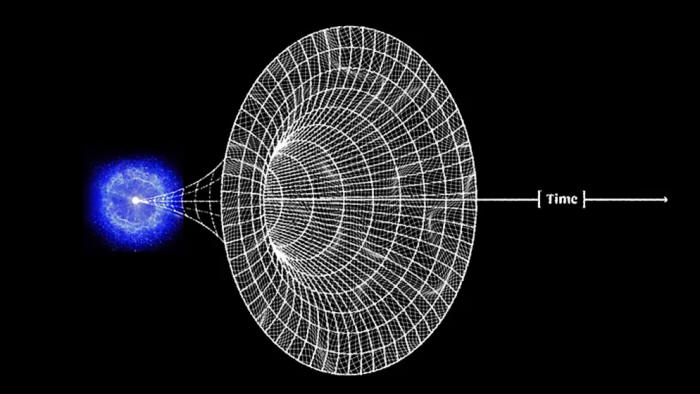
|
From a region of space as small as can be
imagined (all the way down to the Planck scale), cosmological
inflation causes space to expand exponentially: relentlessly
doubling and doubling again with each tiny fraction-of-a-second that
elapses. Although this empties the Universe and stretches it flat,
it also contains quantum fluctuations superimposed atop it:
fluctuations that will later provide the seeds for cosmic structure
within our own Universe. What happened before the final ~10^-32
seconds of inflation, including the question of whether inflation
arose from a singular state before it, not only isn't known,
but may
be fundamentally unknowable.
(Credit: Big Think / Ben Gibson) |
And this, at last, is where our knowledge comes
to an end:
not with a gap, but rather with a cliff of ignorance...
Inflation, by its very nature, is a period where there was an
incredible amount of energy locked up in the fabric of empty space
itself.
In this state, space expands at a relentless, exponential
pace, doubling in size in all three dimensions in just a tiny
fraction of a second, and then doubling again and again and again
with each subsequent fraction of a second that elapses.
However, because our observable Universe is of a finite size, this
means that only the final small fraction-of-a-second of inflation
leaves any imprint on our Universe:
it's from that brief epoch that
we've been able to determine that inflation occurred at all.
For
everything that came before it, including:
-
answers to the question of how long
inflation endured
-
answer to the question of whether inflation was eternal or whether
it started from some pre-inflationary conditions,
what those
pre-inflationary conditions were
-
and whether there was an ultimate beginning to, say, what we think
of as the fundamental entities of space, time, and the laws of
physics that govern them,
...we simply have no information, only speculations...!
Science, remember, doesn't give us
the ultimate answers to our inquiries:
it simply
gives us the best approximation of reality, given our current state
of knowledge, that is consistent with all the evidence we've
collected to this point.
We've come incredibly far in our quest to
make sense of the Universe, and while there are still open questions
that science is pursuing, the broad strokes - plus a great many
details - of "where we come from" are finally known.
|











